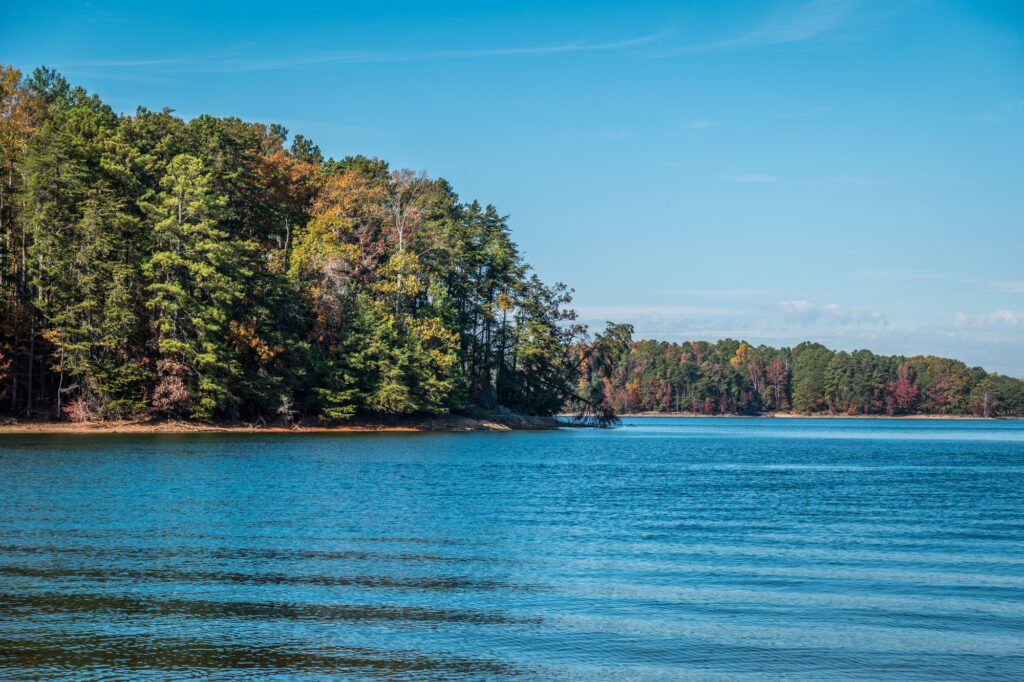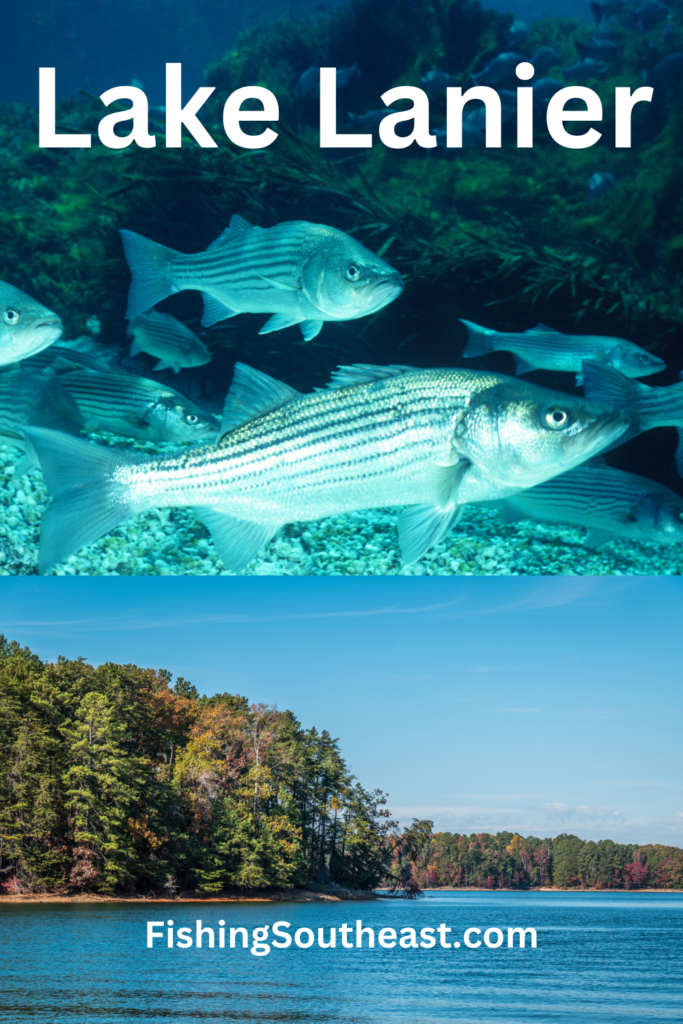
The story of Lake Lanier began more than half a century ago, in the heart of the American South. It’s an intriguing tale that has transformed the local landscape and left a lasting legacy for generations of fishing enthusiasts like us.
Lake Lanier was birthed from the vision to create a multipurpose reservoir that would provide flood control, power production, and water supply. The U.S. Army Corps of Engineers played a pivotal role in bringing this vision to life, setting the wheels in motion in the early 1950s.
Named after the esteemed Georgian poet, Sidney Lanier, Lake Lanier’s creation began with the construction of Buford Dam on the Chattahoochee River. Buford Dam, the cornerstone of the lake, was built over a five-year period, from 1950 to 1956. This massive construction project was no small feat. The dam, measuring an impressive 2,360 feet long and 192 feet high, resulted in the creation of a reservoir that would soon become the much-loved Lake Lanier.
Once the dam was completed, it took another three years for the lake to reach its full pool level. Imagine the anticipation as the water levels slowly rose, and the realization of a dream came closer with each passing day.
Since its inception, Lake Lanier has witnessed various transformations, becoming a popular spot for recreation and fishing. Today, with its charming islands, sprawling shoreline, and abundant fish populations, Lake Lanier has far surpassed its original utility objectives.
Spanning 59 square miles with a whopping 690 miles of shoreline, Lake Lanier is home to a diverse range of fish species and plenty of idyllic fishing spots. So, what makes it so good for fishing?
The Fishing Experience at Lake Lanier
When it comes to fishing, Lake Lanier is nothing short of a paradise for enthusiasts like us. The uniqueness of the experience lies not only in the variety of fish species but also in the lake’s diverse landscape, abundant fishing spots, and the sheer tranquility that it offers.
Types of Fish in Lake Lanier
Lake Lanier is a rich and diverse ecosystem with a wide variety of fish species, making it an angler’s delight. The lake’s most sought-after inhabitants include the Spotted Bass, Largemouth Bass, and Striped Bass, each of which provides a unique challenge and thrill. If you’re a bass enthusiast, this lake is a dream come true.
For the crappie lovers, Lake Lanier offers both Black and White Crappie, each capable of reaching substantial sizes. There’s something profoundly satisfying about the challenge of enticing these elusive creatures onto your hook.
Other fish species you can find in Lake Lanier include Catfish, Bream, and Walleye. The sheer diversity of fish species in Lake Lanier ensures that every fishing trip is a new adventure, a new challenge, and a new story waiting to unfold. Have you ever wondered about the tales each fish could tell if they could speak?
Best Fishing Spots in Lake Lanier
Lake Lanier, with its expansive 37,000-acre surface area, boasts a multitude of fishing spots. Each spot offers a different kind of experience and a different set of challenges.
Some of the best fishing spots in Lake Lanier include Flat Creek and Balus Creek. Flat Creek, with its depth and structure, is particularly known for Spotted Bass. Picture yourself there on a calm morning, casting your line and waiting for the gentle tug that signals a catch. It’s not just fishing; it’s an encounter with nature at its finest.
Balus Creek is another excellent spot, particularly if you’re after Crappie. In the cooler months, Crappie tend to flock here, offering anglers the perfect opportunity for a fruitful fishing session. Can you imagine the thrill of reeling in a record-sized crappie?
Don’t forget about Two Mile Creek, especially if you’re a Striped Bass enthusiast. Picture the powerful pull of a Striped Bass on your line and the adrenaline rush that comes with it.
Fishing Guides at Lake Lanier
If you prefer a guided fishing experience then you will want to hire a local guide that has thorough knowledge of the lake and can take you to where the fish are. Here’s a few of the best known fishing guides on Lake Lanier:
The Art and Joy of Fishing in Lake Lanier

Fishing in Lake Lanier goes beyond the simple act of catching fish. It’s about soaking up the breathtaking views, the peace and tranquility, the birdsong and the gentle lapping of the water against the shore. It’s about the camaraderie shared with fellow anglers, the tales of ‘the one that got away’, and the shared anticipation of what each new cast might bring.
Moreover, the lake’s surroundings offer an ambiance of serenity and beauty that amplifies the joy of fishing. Picture the sun setting over the lake, casting a golden hue over everything, as you reel in your final catch of the day. Is there any better way to end a day of fishing?
Each fishing trip to Lake Lanier is not just a journey to catch fish, but an experience that nourishes the soul, stokes the spirit of adventure, and creates memories that last a lifetime.
Key Considerations When Fishing in Lake Lanier
Fishing at Lake Lanier can be a fulfilling experience, but success requires more than just casting a line into the water. To make the most out of your trip, there are some key factors that you should consider – from understanding the seasonal fishing patterns and choosing the right equipment to adhering to the local licensing rules and regulations.
Seasonal Fishing Patterns
In Lake Lanier, like any other fishing spot, fish behavior varies with the seasons, and understanding these patterns can make all the difference in your catch rate.
Spring, for instance, is the spawning season for most fish species, including bass and crappie. During this period, they tend to move to shallow areas, making them easier to catch. Can you feel the excitement of reeling in a hefty bass on a cool spring morning?
Summer sees fish like bass going deeper into the lake to escape the heat, requiring different tactics and deeper-diving lures. Night fishing becomes especially popular in the warmer months, with the cool, serene Lake Lanier nights offering an entirely different kind of thrill.
Fall brings the turnover period when water temperature equalizes, making fish more active and evenly distributed throughout the lake. And in winter, although many fish become less active, species like the striped bass turn it into a peak time. Have you ever felt the cold winter air on your face as you fight a feisty striped bass on the line?
Equipment Essentials for Lake Lanier
Just like a carpenter wouldn’t go to work without his tools, a good angler never sets out without the right fishing gear.
The essentials include a sturdy rod and reel combo suitable for the species you’re targeting. For example, a medium-heavy rod with a fast action is a great choice for bass fishing.
Your tackle box should contain an assortment of lures, baits, and hooks. Soft plastics and jigs are popular for bass, while live minnows work great for crappie. Don’t you love the anticipation of seeing which bait the fish prefer each day?
Don’t forget accessories like fishing lines, weights, bobbers, and a good fishing net. And of course, a sharp knife, a cutting board, and a cooler to keep your catch fresh. Because what’s better than ending a day of fishing with a fresh, self-caught meal?
Marinas at Lake Lanier
If you need access to a boat ramp, service or fuel then you will need a good marina. Here’s a list of popular marinas located at Lake Lanier:
- Aqualand Marina
- Bald Ridge Marina
- Gainesville Marina
- Habersham Marina
- Hideaway Bay Marina
- Holiday Marina
- Lazy Days Marina
- Port Royale Marina
- Sunrise Cove Marina
Licenses and Regulations
Fishing is all about respecting the environment and the local regulations, which are designed to protect and preserve our beloved fishing spots. In Georgia, everyone over 16 needs a fishing license, which is easy to get online or from local dealers.
Remember to check the local regulations about catch limits, size limits, and any specific rules about different fish species. After all, responsible fishing is not only ethical but also ensures that future generations can enjoy the same thrilling experiences that we do.
Fishing in Lake Lanier, with its diverse fish population and beautiful landscapes, can be a memorable experience. But remember, success comes to those who plan and prepare. So, are you ready to take on the challenge and reel in your best catch?
If you’re looking for a guided fishing experience then you will want to hire a local guide that has thorough knowledge of the lake and can take you to where the fish are. Here’s a few of the best known fishing guides on Lake Lanier:
My Top 5 Fishing Tips for Lake Lanier
Fishing at Lake Lanier is a delightful adventure. Whether you’re a seasoned angler or a beginner, the right tips can make all the difference. Here are my top 5 fishing tips, based on personal experiences and many rewarding days spent at the lake.
1. Understand Your Fish
Knowledge is power, and this is especially true when it comes to fishing. Understanding the behavior, diet, and preferred habitats of your target species in Lake Lanier can significantly improve your chances of a successful catch. Bass, for instance, are structure-oriented fish that often hide around docks, rocks, or fallen trees. Targeting these areas could yield fruitful results.
2. Choose the Right Time of Day
As a rule of thumb, early morning and late afternoon are often the best times for fishing, when fish are most active. However, some species like Striped Bass are more active at night. How thrilling is it to catch a fish under the starlit sky?
3. Use the Appropriate Gear and Bait
Depending on the species you’re after, your choice of gear and bait will differ. A medium-heavy rod with a fast action is typically a good choice for Bass fishing. For baits, live minnows work great for Crappie, while soft plastic lures are often preferred for Bass.
4. Be Patient and Observant
Patience is the key to successful fishing. It’s not always about constant casting and reeling. Sometimes, it’s more effective to let your bait sit for a while. Also, be observant of the water and weather conditions, as well as signs of fish activity like jumping fish or water disturbances.
5. Practice Catch and Release
While it’s exciting to take home a great catch, consider practicing catch and release, especially for larger, breeding-sized fish. This approach ensures the sustainability of fish populations for future generations to enjoy. Plus, isn’t the thrill of the catch what we’re really after?
Remember, fishing is as much about enjoying the process as it is about the final catch. With these tips in hand, I hope your next trip to Lake Lanier is both successful and immensely enjoyable. So, are you ready to embark on your next fishing adventure?
Here’s a list of popular marinas located at Lake Lanier:


